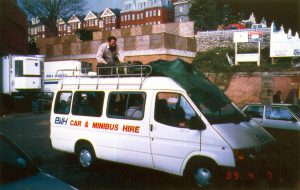
On Friday morning, April 7th, after much preparation over several months including a weekend recce, the WIRG French Foray got underway. I was met outside my gate by Jeremy Hodgkinson and Reg Houghton in a white minibus to which was attached a piece of cardboard announcing ‘THE IRON BUS’.
The plan was for a group of Wirgers to visit the Pays de Bray in northern France to see where the ancestors of some of the Wealden iron founders had come from. Brian Awty, who had been researching in the Pays de Bray for some ten years, led the trip. Also in the minibus was Bernard Worssam, a geologist who looked at that aspect of the trip. In fact we all had things to contribute, both professional and amateur alike.
We drove across to Folkestone, collecting more of the party en route. On arriving at Folkestone Harbour we saw that the Channel was choppy, a blue sea flecked with white horses battering the greensand and chalk cliffs. The train connecting with the ferry delayed our departure by an hour but finally we were underway. At first many of us stayed below; then, one by one, we went up on deck and were rewarded by great views, both Cap Griz Nez and the White Cliffs of Dover were visible, as was Dungeness Nuclear Power Station. As we drew nearer to France the different pattern of farming was clearly visible on fields beyond the cliff top, and approaching Boulogne harbour we could see the cliffs were sands and clays with a mini-fold in one section. The customs formalities completed we drove out from the town towards Neufchâtel en Bray, our base for the weekend.
At first we drove through the Boulonnais, this is a semicircular region of low land, surrounded by a chalk escarpment, leading to Cap Griz Nez in the north. The houses here are built of yellow limestone, like Cotswold stone, and from the same geological age – the Jurassic. We were soon climbing the escarpment so similar to the Downs at home. Most of our 80 mile drive to Neuchatel was over a huge chalk plateau in which Salisbury plain would easily be lost. It was intensively farmed and cut by deep valleys. We passed near the Forêt de Crecy and a large beech forest, Forêt d’Eu, which was under an interesting system of woodland management with young and old groves of trees at varying stages of growth. It was getting dark, black clouds unleashed curtains of rain against an ochrey yellow sky as we descended the steep hill to Neufchâtel. On arrival at Hotel les Arielles we found our rooms then came down to the evening meal.
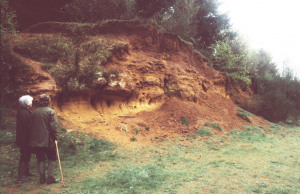
Next morning we left Neufchâtel at 9.00 am. It was misty and ghostly silhouettes of old apple trees laden with mistletoe showed through the fog. This mistletoe goes to England at Christmas. The first stop was a brief visit to a factory built by a stream at Les Forges de Milly. Then we went via Beauvais, the medieval town still dwarfed by its abbey, to Rainvillers. Here was plenty of slag near the bay, which was planted with a form of black poplar. The trees reflected in water by the bay made a beautiful picture redolent of an impressionist painting. At this site we were met by Messrs. Belloste and Cartier who invited us to visit a quarry in the rock formation where the iron came from, also Rainvillers church which was built of local stone. This added interest to the tour.
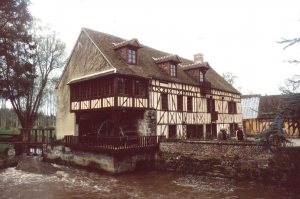
After visiting Forge le Bequet we saw Le Moulin du Fourneau. Here a large medieval-type mill had been built. Apart from the building the undershot waterwheel took our attention. Close by, part of the furnace seemed to form a foundation for the building, now a country house. The owner and family were pleased we took an interest in their abode.
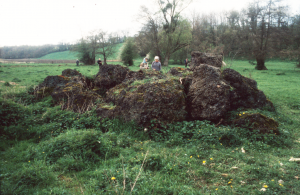
After a brief stop for lunch we left the lowlands and climbed the southern chalk scarp to visit Les Forges du Vaumain where we found a large pile of forge bottoms in a field. Downstream we looked at a pond site. Then on via Gisors in the Epte valley to Gourney, Mont Louvet and La Forge du Petit Vivier de Bray, the latter a very flat site. Somewhere between these we went through the Forêt du Bray then on to La Fayal. At Glinay we walked along an old sunken road by which we saw wild solomon’s seal. Here by the stream was a lot of blue and green slag, nearby was a large bay. To finish this comprehensive tour we had a look at Les Forges de Beaussault. Associated with this site, which was near the northern chalk scarp, were a church and chateau. By the time we got back to the hotel we were ready to appreciate our excellent dinner!
During the first day the weather had been steadily improving and we started on the second day by visiting and trying to locate La Forge de Acher, and looked at Forge de Frenchy and La Forge d’Hodeng. We went on to Neuville Ferriéres where the site was occupied by a woodyard.
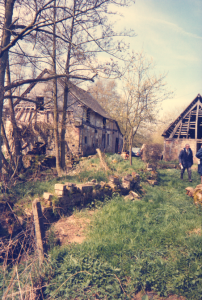
When we had lunch at Neufchâtel it was hot and sunny. We only had a couple of sites to see that afternoon, the most notable being La Forge des Îles. Unfortunately the farmer had been expecting a small party, not a group of 15, so at first we were not welcome. After some negotiation it was finally agreed that we could go onto his land. Jeremy led us through the gate and we followed in single file on our best behaviour. On our return after examining the site the farmer had cooled down and entente cordiale was restored. Finally we had a look at the small museum in Neufchâtel which was devoted to some of the local history and had an interesting collection of firebacks.
We drove from Neufchâtel to Dieppe where the chalk hills curve to meet. This geological trend continues beneath the Channel to connect with the Isle of Wight. After some delay we boarded the ferry and soon set sail for Newhaven. Dieppe is almost a mirror image of Newhaven, both being at river mouths, both surrounded by chalk cliffs which are marked by Tertiary deposits sludging down during bad weather. We waited on deck to see France disappear in the sunset. The weather changed again, becoming overcast. After a meal we emerged on deck again to see the lights of Brighton and Seaford, the Royal Sovereign and Beachy Head lights. Soon we were in Newhaven harbour.
This was the perfect end to a great trip. We had visited 17 sites and looked at all aspects of history and geology etc. A successful French foray.
D. Nicol
More photos of this Study Visit can be seen in the Photo Archive
